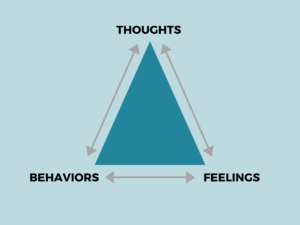Overcoming Black and White Thinking
The way we think has enormous power in shaping how we feel. But changing those black and white thoughts isn’t so easy.
What is Black and White Thinking?
Black and white thinking (sometimes referred to as all or nothing thinking or dichotomous thinking) is one version of something called a cognitive distortion. Cognitive distortions refer to the false ways we interpret reality. It’s basically like putting on a pair of blue-tinted lenses and believing that everything in the world has suddenly turned the color blue. Of course that hasn’t actually happened, but these lenses are so convincing that we believe it’s true.
With black and white thinking, our thoughts gravitate towards extremes: the black versus the white, the all versus the nothing. Here are some examples of how that can show up in regular people’s thoughts:
I either know everything or I know nothing
You’re either good or you’re bad
I’m the best or I’m the worst
I will either triumph or I’ll fail
I’m a perfect parent or I’m the worst parent
He either hates me or he loves me
I’m always bad or I’m never bad
You get the gist. Black and white thinking refers to any thoughts that generate polarizing or extreme interpretations of reality instead of finding one of the many points of reference that exist within the middle.
The tricky part about these black and white thoughts is they often don’t show up in pairs. Meaning, your thoughts might only voice one side of the extreme while the opposite comparison remains unvoiced. (ex: “I’m the worst parent ever”, “nothing I do is right”, or “I’ll never figure this out.”
Words like always, never, best, worst, everything, and nothing can be helpful clues that you’re engaging in black and white thinking. That’s because these words themselves are extreme. If you’re the best, that suggests that no one else is better, and if you’re the worst, that suggests no one else is worst.
While these words are at times accurate, most often they are exaggerations of reality.
What are the Consequences of Black and White Thinking?
You might be wondering why we should even care if our thoughts exaggerate reality. The answer to that requires us to better understand how our thoughts shape our experiences in the world.
The cognitive triangle is a psychological concept that refers to the connection between thoughts, feelings, and behaviors. They are all connected in a metaphorical triangle. When something happens, each component influences the others.

So when we engage in black and white thinking, the impact of this is going to extend into our feelings and our behaviors. Let’s consider an example.
Let’s say that you were feeling stressed by work, household chores, and parenting demands, all piling up around you. As you’re trying to tackle it all, one step at a time, in walks your child, who asks for a snack. Because you’re already feeling overwhelmed, you respond less than ideally and snap, “No! Stop interrupting me!,” and your child falls to the floor in tears.
If the black and white thinking were to show up, it might say something like “Oh my god, I’m the worst mom.” That thought is likely going to make you feel ashamed, inadequate, and depressed, and those feelings, in turn, might lead you to beat yourself up in your head or give up trying altogether. After all, if you really are the worst mom, what’s the point in even trying?
But suppose instead, after you snapped at your child, you said to yourself, “wow, that really didn’t help the situation. What can I do to make this better?” That thought is MUCH less likely to lead you feeling ashamed, inadequate or depressed. Perhaps these thoughts lead you to feel frustrated, but still motivated to work it out with your child. These feelings then allow you to respond to your child with hugs and apologies, making both you and your child feel better.
These two scenarios start with the exact same situation (you snapping at your child), but your thoughts lead to two very different outcomes.
This is why identifying and overcoming black and white thinking is important: because your thoughts provide you with the power to influence your reality.
So, how do we go about changing these unhelpful ways of thinking?
How to Overcome Black and White Thinking
1. Identify patterns of black and white thoughts
You can’t change what you don’t even realize exists, so the first step in overcoming your black and white thinking is to recognize it’s there. But how do you do this?
It’s impossible to suggest that anyone can be aware of their thoughts at all times. Not only is this not realistic, it’s also not beneficial. Because our thoughts are running non-stop all day long everyday, and if we were to devote our attention entirely to them, we would miss out on the world around us.
So I recommend using your negative feelings as a reminder to pay attention to your thoughts. Most of us recognize when we’re not feeling good, whether that’s angry, sad, guilty, or whatever else. So when we notice a difficult feeling, that’s a great time to stop and ask: What am I thinking right now?
2. Evaluate the accuracy of your thought
I mentioned earlier that we tend to accept our thoughts as reality, but we can learn to start questioning them. This is important if we truly want to overcome our black and white thinking. Some questions to guide you in your evaluation include:
Is this thought 100% accurate?
Are there any examples that contradict this thought?
Could I convince a judge or my best friend this thought is true?
Of course there are times when the extreme end of the spectrum is actually accurate, but this is rare. Using these questions can help you recognize when you are putting yourself in an extreme box that doesn’t fit.
3. Find a middle ground
Once you identify a thought as inaccurate, then it’s time to create a more realistic replacement. But we want to be careful here that we don’t replace the black and white thought with another unhelpful thought. Instead, we’re aiming to find a thought that is both accurate and helpful.
In order to create this replacement thought, it’s helpful to refer back to your answers in step 2. Instead of the exaggerated extreme thought, what is a more accurate description? Some helpful hints:
Always and never can turn into sometimes.
Best and worst can be modified to “pretty good,” “working on it,” or “improving.”
Everything and nothing can transform into “some things.”
We’re aiming for the gray zone here between the black and white.
But finding the gray zone isn’t enough when we’re working on changing those extreme thoughts. We also want to make sure the new thought is helpful.
For example, imagine that the original black and white thought you wanted to modify was “I’m not good at anything.” It would technically be finding the gray zone by turning that into “I’m pretty bad at some things,” but leaving it at that is not likely to lead you to feel any better. So you’re going to want to add in a helpful spin. Something like “I’m pretty bad at some things, but I’m great at others.” See how that final addition is likely to improve how you feel?
So to recap, when you replacing your black and white thoughts, you want to add in a new thought that is both accurate and helpful.
4. Repeat 1 million times
Changing your thoughts is one of those things that happens little by little over time, so try and not get discouraged when those black and white thoughts keep popping up. Instead, keep in mind that this is something you will need to repeat over and over, and over again. The more you practice this act of identifying and modifying your black and white thoughts, the easier it will get.
And there you have it. Hopefully you now understand what is black and white thinking, what it’s consequences are, and how to overcome that pattern of thinking. Remember, it’s ok to not be perfect at this (in fact, if you’re aiming for perfection, then there’s likely another black and white thought lurking underneath that goal). Find comfort in knowing that you are one of many who encounters these thoughts, and with a little persistence, you can overcome them!
______
Dana Basu, PsyD is a licensed clinical psychologist and founder of EverGROW therapy. She provides individual therapy, support groups, and online resources for parents in Orange County and throughout the state of California via online therapy. She specializes in working with people with difficult childhood experiences, trauma, parenting stress, and chronic guilt.


